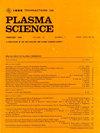Reduced Order Spacecraft Charging Models for Electrostatic Proximity Operations
IF 1.3
4区 物理与天体物理
Q3 PHYSICS, FLUIDS & PLASMAS
引用次数: 0
Abstract
Spacecraft charge in orbit due to naturally occurring electric currents from the ambient plasma emitted from the surface, as well as artificial currents produced by devices such as an electron gun. This results in electrostatic forces and torques between two spacecraft in close proximity that can perturb the relative motion and attitude during on-orbit servicing, assembly, and manufacturing (OSAM) operations. The forces and torques may also be utilized to remove or detumble dysfunctional satellites. In prior work on electrostatic proximity operations, typically charging models based on spherical spacecraft were used to compute the electrostatic potential, and that potential was prescribed to be constant in relative motion simulations. In this work, several charging models are compared for spacecraft with nonspherical shapes, including simple sphere models and faceted models. The faceted model is promising because its total surface area is more accurate, and it allows for the consideration of a time-varying sunlit area and ram-facing area. It is shown that the orientation of the spacecraft with respect to the Sun can significantly affect the equilibrium potential and the resulting force and torque. This is demonstrated by a charged attitude motion simulation for the electrostatic tractor (ET) debris removal concept. The effect of differential charging on the electrostatic force and torque is investigated. It is shown that differential charging can lead to significant force differences with respect to a fully conducting spacecraft, including a switch from repulsive to attractive force components.静电接近操作的航天器降阶充电模型
宇宙飞船在轨道上充电是由于从表面发射的环境等离子体产生的自然电流,以及由电子枪等设备产生的人工电流。这导致两个航天器之间的静电力和扭矩接近,可以扰乱在轨维修,组装和制造(OSAM)操作期间的相对运动和姿态。力和扭矩也可用于移除或击毁功能失调的卫星。在以往的静电接近操作中,通常采用基于球形航天器的充电模型来计算静电势,并且在相对运动模拟中规定静电势为常数。本文对非球面航天器的几种装药模型进行了比较,包括简单的球面模型和面形模型。面模型很有前途,因为它的总表面积更准确,并且它允许考虑时变的阳光照射面积和面向ram的面积。结果表明,航天器相对于太阳的方向可以显著影响平衡势和产生的力和扭矩。这是证明了带电姿态运动模拟的静电拖拉机(ET)碎片清除概念。研究了差动充电对静电力和转矩的影响。结果表明,相对于完全导电的航天器,不同的电荷会导致显著的力差异,包括从排斥力到引力分量的转换。
本文章由计算机程序翻译,如有差异,请以英文原文为准。
求助全文
约1分钟内获得全文
求助全文
来源期刊

IEEE Transactions on Plasma Science
物理-物理:流体与等离子体
CiteScore
3.00
自引率
20.00%
发文量
538
审稿时长
3.8 months
期刊介绍:
The scope covers all aspects of the theory and application of plasma science. It includes the following areas: magnetohydrodynamics; thermionics and plasma diodes; basic plasma phenomena; gaseous electronics; microwave/plasma interaction; electron, ion, and plasma sources; space plasmas; intense electron and ion beams; laser-plasma interactions; plasma diagnostics; plasma chemistry and processing; solid-state plasmas; plasma heating; plasma for controlled fusion research; high energy density plasmas; industrial/commercial applications of plasma physics; plasma waves and instabilities; and high power microwave and submillimeter wave generation.
 求助内容:
求助内容: 应助结果提醒方式:
应助结果提醒方式:


